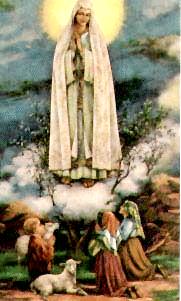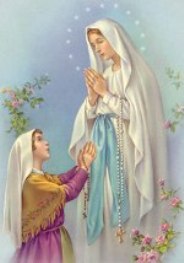The Most Holy Rosary Of The Blessed Virgin Mary
"I am the Lady of the Rosary" ~~ Speaking to the three children of Fatima.

'Wonder not that you have obtained so little fruit by your labors, you have spent them on barren soil, not yet watered with the dew of Divine Grace. When GOD willed to renew the face of the earth, He began by sending down on it the fertilizing rain of the Angelic Salutation. Therefore preach my Psalter composed of 150 Angelic Salutations and 15 Our Fathers, and you will obtain an abundant harvest'.
'The rosary shall be a powerful armor against hell, it will destroy vice, decrease sin, and defeat heresies. It will cause virtue and good works to flourish; it will withdraw the hearts of men from the love of the world and its vanities, and lift them to the desire of eternal things.'
~~ Words of the Blessed Virgin Mary to Saint Dominic
Prayer To The Lady Of The Rosary
Beloved Lady of the Rosary, I thank you for your great gift of your psalter. As the beads slip through my fingers, may my heart and my lips sing your praise, and my brain contemplate those sacred mysteries of my Holy Faith. May my meditations on your beloved Rosary draw me ever closer, trustingly, to you, and through you to your divine son, my Lord and my God.
The Mysteries of Rosary of The Blessed Virgin Mary
Joyful Mysteries
Often said on Monday and Saturday, the Joyful Mysteries include: The Annunciation, The Visitation, The Birth of Our Lord, The Presentation of Our Lord, and The Finding of Our Lord in the Temple.
Glorious Mysteries
Often said on Wednesday and Sunday the Glorious Mysteries include: The Resurrection, The Ascension, The Coming of the Holy Spirit, The Assumption of our Blessed Mother into Heaven, and The Coronation of our Blessed Mother.
Mysteries of Light
Often said on Thursday, the Mysteries of Light as inspired by and proposed in 1957 by Saint George Preca:
-
1. When Our Lord Jesus Christ, after his baptism in the Jordan, was led into the desert.
-
2. When Our Lord Jesus Christ showed, by word and miracles, that He is true God.
-
3. When Our Lord Jesus Christ taught the Beatitudes on the mountain.
-
4. When Our Lord Jesus Christ was transfigured on the mountain.
-
5. When Our Lord Jesus Christ had his last Meal with the Apostles.
Sorrowful Mysteries
Often said on Tuesday and Friday the Sorrowful Mysteries include: The Agony in the Garden, The Scourging at the Pillar, The Crowning with Thorns, The Carrying of the Cross, and The Crucifixion and Death of Our Lord.
History Of The Rosary
Tradition holds that Our Lady gave the Rosary to Saint Dominic Guzman in 1206 as a form of gospel-preaching and popular prayer. For more than seven centuries, the Rosary devotion has been one of the most popular devotional practices in the church. Its combination of vocal and mental prayer have made it a prime tool for contemplation. Jesus Christ is the author and source of grade; Our Lady's Rosary is the key to open the treasury of grace to us.
Although prayer beads had been popular before Dominic's time, he and his friars quickly adopted the Rosary as an excellent way to teach the mysteries of Christianity to a largely illiterate European population. In 1470, Blessed Alan of Rupe founded the first Rosary Confraternity, and thereby launched the Dominican Order as the foremost missionaries of the Rosary. Through the efforts of Blessed Alan and the early Dominicans, this prayer form spread rapidly throughout Western Christendom.
The meditations on the fifteen mysteries serve as reminders of incidents in the lives of Christ and Mary. These are divided into the joyful, sorrowful, and glorious mysteries. Thirteen of the mysteries come from incidents in the New Testament. One, the assumption of Mary into heave, comes from Sacred Tradition. The fifteens, the Crowning of Mary as Queen of Heaven is thought to be derived from images in the Book of Revelation. These meditations make the Rosary a reflection on the fundamental beliefs of our Faith.
Through the years, Our Lady has re-affirmed her approval of this devotion, and her pleasure in the title "Queen of the Rosary." To Blessed Alan, she made fifteen promises to those who devoutly recite her beads. She told him, ".. immense volumes would have to be written if all the miracles of my Holy Rosary were to be recorded." Our Lady's promises are:
-
-
-
-
-
It shall make virtues and good works to flourish again; it shall obtain for souls abundant mercies of God; it shall win the hearts of men from the love of the world and its vanities, and life them to a desire of things eternal. Oh, how many souls will be sanctified by this means !
-
-
-
Whoever shall have recited the Rosary devoutly and with meditation on its mysteries, shall never be overcome by misfortunes, shall not experience the anger of God, shall not be lost by a sudden death; but if he be in sin he shall be converted; and if he be in grace, he shall persevere and be made worth of eternal life.
-
-
-
It is my will that those who recite my Rosary have, in life and in death, light and the plenitude of graces; and in life and death, may participate in the merits of the saints.
-
-
-
-
-
-
-
Our Lady told Blessed Bartolo Longo to propagate the Rosary, and promised that those who would propagate this devotion would be saved. In 1884, Our Lady of Pompeii appeared at Naples to Fortuna Agrelli, who was desperately ill. She told Fortuna that the title "Lady of the Holy Rosary" was one which was particularly pleasing to her, and cured Fortuna of her illness.


At Lourdes, Our Lady told Saint Bernadette to pray many rosaries. When Bernadette saw the beautiful lady, she instinctively took her Rosary in her hands and knelt down. The lady made a sign of approval with her head, and took into her hands a Rosary which hung on her right arm. As Bernadette prayed, Our Lady passed the beads of her Rosary through her fingers, but said nothing except the Gloria at the end of each decade. At Fatima, Mary told the children to pray the Rosary often.
Popes throughout history have loved the Rosary. Not a single Pope in the last four hundred years has failed to urge devotion to the Rosary. From Pope Sixtus IV, in 1479, to the present day, all popes have urged the use of this devotion, and enriched its recitation with indulgences.
Pius XI dedicated the entire month of October to the Rosary.
Pope Saint Pius X said :
-
"Of all the prayers, the Rosary is the most beautiful and the richest in graces; of all, it is the one most pleasing to Mary, the Virgin Most Holy."
Pope Leo XIII repeatedly recommended the Rosary as a most powerful means whereby to move God to aid us in meeting the needs of the present age. In 1883, he inserted the invocation, "Queen of the Most Holy Rosary, pray for us ! " into the Liturgy for the Universal Church. John XXIII who was particularly faithful to the daily recital of the whole Rosary has said, " We can never sufficiently recommend the saying of the Rosary, not simply with the lips but with attention of the soul to the divine truths, with a heart filled with love and gratitude." John Paul II tells us to "... love the simple, fruitful prayer of the Rosary." Many of the Saints, and a number of the religious orders have praised the Rosary. Saint Charles said he depended on the Rosary almost entirely for the conversion and sanctification of his diocese. Founders of most religious orders have either commanded or recommended the daily recitation of the Rosary. The Benedictines speedily adapted this devotion in their ancient cloisters. The Carmelites were happy to receive the Rosary as well as their rule from the Dominicans. The Franciscans made their rosaries out of wood, and preached this devotion as well as poverty. The Servites wore their rosaries as a badge of that servitude which is the only true liberty. Inspired by the example of their founder, the Jesuits invariably propagated the devotion. Saint Francis Xavier used the touch of his chaplet as a means of healing the sick. Saint Vincent de Paul instructed the members of his order to depend more on the Rosary than upon their preaching.
Our ancestors had recourse to the Rosary as an every- ready refuge in misfortune, and as a pledge and a proof of their Christian faith and devotion. Saint Dominic used the Rosary as a weapon in his battle against the Albigensian heresy in France. In the last century, the Christian successes over the Turks at Temesvar and at Corfu coincided with the conclusion of public devotions of the Rosary. During the penal days in Ireland, the Rosary bound the Irish Catholics together as the church militant. When it was a felony to teach the Catholic Catechism, and death for a priest to say Mass, the Irish mothers used their rosaries to tell their little ones the story of Jesus Christ and Mary, and thus kept the Faith green in the hearts of their children. Saint John Vianney, the Cure d'Ars, declared emphatically that in the nineteenth century it was the Rosary which restored religion in France. Likewise, in the dark days of persecution in Mexico, in our own century, the sturdy Mexican Catholics clung faithfully to their rosaries. The martyr Miguel Pro was allowed his last request before being shot by a firing squad --- he knelt and prayed his Rosary. A special society, the Society of the Living Rosary, was founded by the Venerable Marie Pauline Jaricot in the city of Lyons, France, in 1826. She formed bands of fifteen members who each said one decade of the Rosary daily. Thus, the entire Rosary is said collectively by the members of each circle daily.
Father Timothy Ricci, O.P., instituted the Perpetual Rosary, or Mary's Guard of Honor, in 1635. The aim of this devotion is to unite the members in such a way that some devoted watchers will ever be found in prayer and praise at Our Lady's shrine, telling their beads for the conversion of sinners, the relief of the dying, and the succor of the dead. In Belgium, the Dominican nuns of the Third Order established a monastery for the express purpose of maintaining the Perpetual Rosary, so that there it became not merely the devotion of a society, but the distinctive work of a community. A number of shrines of the order are to be found in the United States. Here, the Rosary is said day and night by members of the community. Rosary processions are held, and pilgrims sing again and again the praises of the Heavenly Queen of all Roman Rite Catholics.
-
Our Lady has 117 blessed titles. Above all, She selected this title at Fatima: "I am the Lady of the Rosary."
-
-
-
-
-
-
-
-
John XXIII spoke 38 times about our Lady and the Rosary. He prayed 15 decades daily.
-
Remember, O most gracious Virgin Mary that never was it known that anyone who fled to Your protection, implored Your help, or sought Your intercession was left unaided. Inspired with this confidence, we fly to you, O Virgin of virgins, our Mother. To You we come; before You we stand, sinful and sorrowful. O Mother of the Word Incarnate, despise not our petitions, but in Your mercy, hear and answer us. Amen.